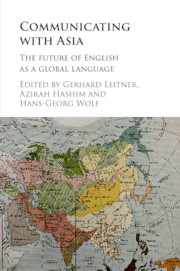Book contents
- Communicating with Asia
- Communicating with Asia
- Copyright page
- Contents
- Figures
- Tables
- Contributors
- Book part
- Communicating with Asia: introduction
- Part I English in selected regional and national habitats with a glance at the role of outward-bound communication needs
- Part II Major other languages in Asia, their international status and impact on education
- 10 Multilingualism, Hindi–Urdu and Indian English: intranational and international diaspora
- 11 Bahasa Indonesia and Bahasa Melayu: convergence and divergence of the official languages in contemporary Southeast Asia
- 12 Putonghua and Cantonese in the Chinese territories
- 13 The Chinese language in the Asian diaspora: a Malaysian experience
- 14 Russian in Far East Asia: linguistic policies on the periphery of empire
- 15 Russian and Turkic languages in Central Asia
- Part III Wider perspectives
- Bibliography
- Index
11 - Bahasa Indonesia and Bahasa Melayu: convergence and divergence of the official languages in contemporary Southeast Asia
from Part II - Major other languages in Asia, their international status and impact on education
Published online by Cambridge University Press: 05 January 2016
- Communicating with Asia
- Communicating with Asia
- Copyright page
- Contents
- Figures
- Tables
- Contributors
- Book part
- Communicating with Asia: introduction
- Part I English in selected regional and national habitats with a glance at the role of outward-bound communication needs
- Part II Major other languages in Asia, their international status and impact on education
- 10 Multilingualism, Hindi–Urdu and Indian English: intranational and international diaspora
- 11 Bahasa Indonesia and Bahasa Melayu: convergence and divergence of the official languages in contemporary Southeast Asia
- 12 Putonghua and Cantonese in the Chinese territories
- 13 The Chinese language in the Asian diaspora: a Malaysian experience
- 14 Russian in Far East Asia: linguistic policies on the periphery of empire
- 15 Russian and Turkic languages in Central Asia
- Part III Wider perspectives
- Bibliography
- Index
Summary
This chapter outlines the relationship between Bahasa Indonesia and Malay (Bahasa Melayu), the official languages of the modern states of Indonesia and Malaysia. We trace the historical development of these two varieties of Malay from their classical source, Malay, before the advent of government by the colonial powers, and focus our discussion on factors resulting in the divergence that is visible today. We also discuss efforts to standardize the two postindependence languages, including the language policies adopted by the major Malay-speaking countries in the region. The chapter analyzes the differences between Bahasa Indonesia and Malay in terms of vocabulary and grammatical structure and advances certain hypotheses for some of the major remaining differences. Given the geopolitical proximity of Brunei and Singapore we cannot but include what happens to Malay there.
- Type
- Chapter
- Information
- Communicating with AsiaThe Future of English as a Global Language, pp. 170 - 187Publisher: Cambridge University PressPrint publication year: 2016
- 1
- Cited by



